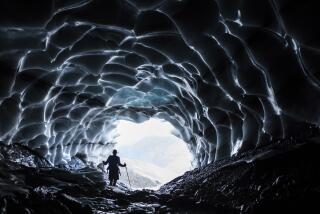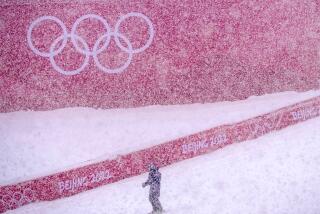Hard Water Climbing Up Austria’s Freezeways
- Share via
SCHONBERG, Austria — “In January the ice is as hard as glass and the ice axes penetrate only to the depth of a thumbnail.”
Tirolean climber Rudi Mayr paused for a second in his description of the ultimate adventure of midwinter: Glacier climbing in the Austrian Alps.
“Every meter is like balancing on raw eggs, every movement is strenuous,” he continued. “The ice bolts squeak every time they are screwed in, as though they needed to be greased. . . .”
But, come March, it’s another story.
Then, says Mayr, “The ice has turned bluish by warmth and sun. Every blow of the ice ax holds, and, with a fraction of the strength needed previously, you slither up the hard water.”
Such is the range of ice-climbing adventures in the Austrian Tirol, where the Winter Olympics have been staged twice and where skiing is described as “just one aspect” of the Tirolian winter.
My wife and I have several times enjoyed downhill skiing and cross-country touring adventures in the Tirol, and I have tried springtime glacier climbing when the ice was turning bluish. But I didn’t exactly “slither” up hard water.
More than a dozen mountaineering schools are offering ice-climbing lessons this winter, and climbs with guides are available at all ability levels.
The Austrian Tirol has five major glacier skiing and climbing areas where you can ski and ice-climb all year. The largest is Stubai Glacier, about 20 miles from the Schonberg exit off the Brenner Pass motorway.
The mountain village of Schonberg is only 10 minutes by car from Innsbruck, capital city of the Tirol and host of the 1964 and 1976 Winter Olympic Games.
Schonberg, gateway to the Stubai Glacier and to all types of winter sports in the surrounding mountains, maintains a fairy-tale setting with its small hotels, inns and guest houses, and their gently peaked roofs and tiers of balconies.
Goethe visited here in 1786. Four years earlier Pope Pius VI stopped in Shonberg during his journey through the Brenner Pass into the heart of Europe. The dramatic span of the Europa Bridge is nearly 600 feet above the valley.
Along the winding road toward the Stubai Glacier, each picturesque village is closely followed by another. Mieder, at the foot of Serles Mountain, is a hub of cross-country ski trails.
There are more than 25 miles of cross-country trails at an altitude of about 5,000 feet, with Alpine warming huts along the way. Ice crystals glow within enchanted forests. Frozen waterfalls are a study in still-life. Another 45 miles of trails are carved across the valley.
Paragliding is a challenging alternative to skiing and ice climbing, and there are schools to give instructions in this sport, too.
There’s also instruction in mono-skiing, telemark skiing and on how to board down the ice-crystalled snow.
The village of Neustift has a paragliding school, the longest natural-sled run in Austria and accommodations ranging from private homes to five-star hotels.
The valley narrows between sculptured white crests as it nears the base of Stubai Glacier. Buses provide transportation between the glacier, villages and Innsbruck.
Stubai opened for year-around skiing in the winter of 1973-74. It has seven lifts and a two-section cabin cableway serving about 10 square miles of slopes. There’s skiing for children and seniors as well as for experts.
Whether you’re ice climbing or skiing, you’ll come across the Gamsgarten self-service restaurant at about the 8,000-foot level.
Climbing courses are offered by various mountaineering schools and Alpine clubs. A week of training in rock- and ice-climbing includes the use of pick-axes and crampons, hacking steps into ice, climbing the ice and rescue from crevasses, as well as the use of ropes and Alpine gear.
This can be followed by a climb or cross-mountain trip with one of the more than 400 guides who work with the various Alpine clubs and mountaineering schools. Most single lessons start at about $25.
A course costing about $390 from the Alpine School of Innsbruck includes overnights in mountain huts and a rock- and ice-climbing diploma. You can bring your own climbing and skiing gear, or rent what you need in Innsbruck and the Stubai Valley villages.
Hotels and guest houses in the Stubai Valley are reasonably priced. Pension Tyrol in Schonberg, run by Birgit and Otto Steixner, has double rooms with private bath beginning at about $35, and includes a buffet breakfast. This Tirolean-styled home has seven rooms nested behind balconies and a sauna.
Ask about discounts and services offered by the Stubai Guest Card and the Stubai Superskipass. Regular daily lift tickets start at about $10. Six-day lift tickets cost about $107.
DER Tours is offering a seven-day package this winter that includes a choice from among five top winter sports areas in Austria, among them the mountains around Innsbruck. The package covers round-trip travel via Munich to selected ski areas in Austria, accommodations for seven nights, continental breakfasts and transportation to the slope area. The rate from Los Angeles is $769 for midweek departures, $939 for weekend. Check with your travel agent or DER Tours, 11933 Wilshire Blvd., Los Angeles 90025, (213) 479-4411.
Lufthansa Airlines, in cooperation with five tour operators, has put together ski packages to the Austrian and Bavarian Alps that start at $819 from Los Angeles and San Francisco, including air fare. You can get the details from your travel agent or Lufthansa at (213) 680-0700.
For more information on the Stubai Valley and other areas throughout the Tirol, contact the Austrian Alpine Club, Wilhelm-Greil-Strasse 15, A-6020 Innsbruck, Austria. Most villages have tourist offices that can help arrange accommodations and skiing and climbing plans.
For more information on the various Alpine clubs and mountaineering schools in the Tirol, or general information on travel to Austria, contact the Austrian National Tourist Office, 11601 Wilshire Blvd., Suite 2480, Los Angeles 90025, (213) 477-3332.
More to Read
Sign up for The Wild
We’ll help you find the best places to hike, bike and run, as well as the perfect silent spots for meditation and yoga.
You may occasionally receive promotional content from the Los Angeles Times.






